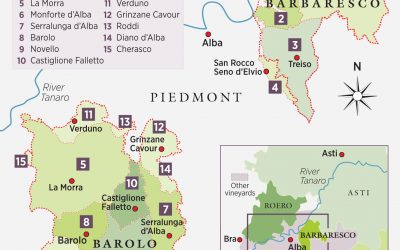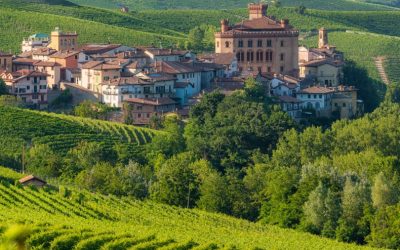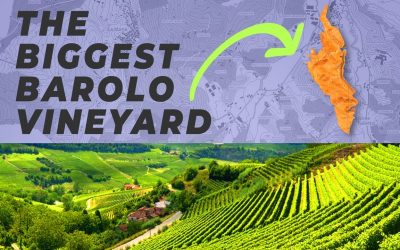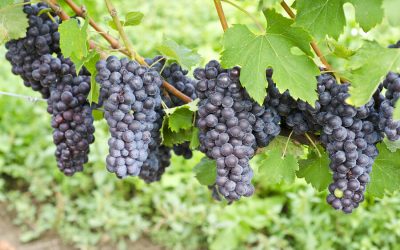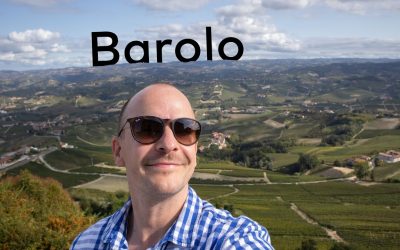What is the Difference Between Barolo Vs Barbaresco: Key differences, wine taste, map, price
Everithig start from the Nebbiolo Grapes
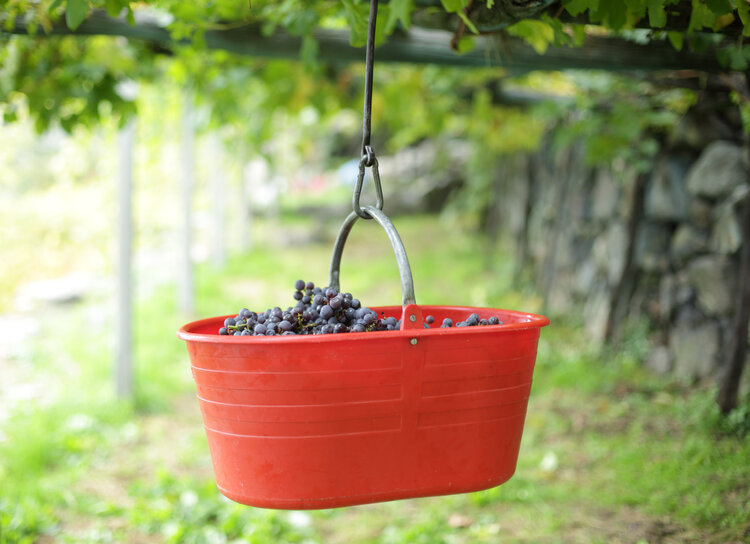
Nebbiolo grape is the cornerstone of both Barolo and Barbaresco wines. This red Italian wine grape variety predominates in the Piedmont region, found particularly in the hills of the Langhe, and named after the fogs – or “nebbia” in Italian – that descend over the vineyards in autumn.
Renowned for its high tannin, acidity, and complex aromas, Nebbiolo produces wines of deep ruby color which lighten to a brick orange with age. Though the grape is not widely grown outside of Italy, its distinctive characteristics and the high-quality wines it produces have gained it an international reputation.
In the hands of winemakers, Nebbiolo expresses itself differently, depending on the terroir and techniques used. However, it always retains a certain finesse and distinctive aromas of tar, cherries, roses, and anise. The age, vineyard location, soil composition, and vinification techniques will all play a role in the final product.
But, the journey of Nebbiolo wines, whether it’s a Barolo or a Barbaresco, truly starts in the vineyard with the cultivation and harvesting of Nebbiolo grapes. These grapes require careful handling and a long growing season, and the reward for this careful cultivation is a powerful, complex, and long-lived wine, truly appreciated by wine lovers around the world.
Barolo Vs Barbaresco Wine Map
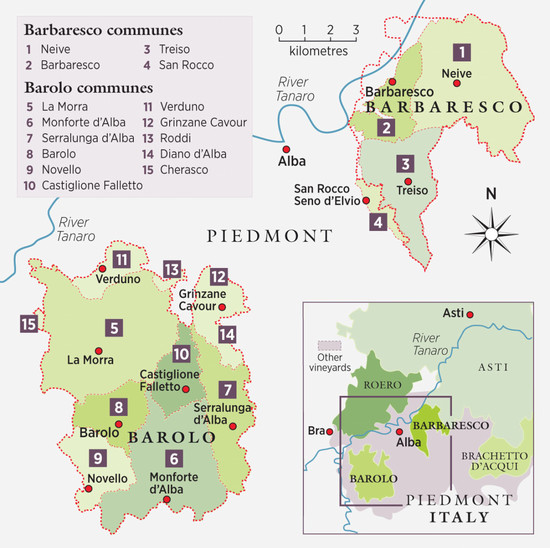
Barolo and Barbaresco are two renowned wine regions located in the Piedmont region in the northwest corner of Italy, surrounded by the Alps.
- Barolo: Often referred to as the “king” of wines, the Barolo region is situated southwest of the town of Alba and spans eleven different communes. It’s divided into two main zones: the Serralunga Valley, which produces more robust wines, and the Central Valley, which produces more aromatic wines. The region includes famous areas such as La Morra, Barolo, Serralunga d’Alba, Monforte d’Alba, and Castiglione Falletto.
- Barbaresco: Known as the “queen” of wines, Barbaresco is located northeast of Alba and is a smaller region compared to Barolo. It includes the communes of Barbaresco, Neive, and Treiso. The wines from Barbaresco are typically a bit lighter and more refined than those from Barolo, but they still have excellent aging potential.
These two regions are just a few kilometers apart and both produce wines exclusively from the Nebbiolo grape. However, due to differences in soil composition, altitude, and microclimate, Barolo and Barbaresco wines have distinct characteristics.
What is the Difference Between Barolo Vs Barbaresco
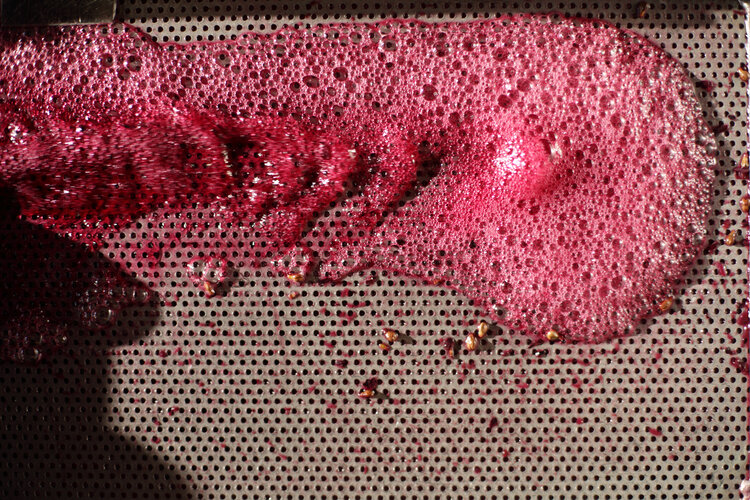
Barolo and Barbaresco are two of the most revered names in Italian wine, both produced in the Piedmont region of northwestern Italy. They share a common grape – Nebbiolo – and, despite some key differences, they have a lot in common, including their potential for complexity and long aging. They are often compared due to their shared heritage and similarities in flavor profile, although each has its distinct characteristics.
The primary difference between Barolo and Barbaresco lies in their geography and the related terroir, which ultimately impacts the wine’s taste, body, and aging potential. Barolo is often described as being more robust and full-bodied, with higher tannins and acidity, which allows it to age and evolve for many years. It is produced in a larger area with more variation in soil composition, leading to a broader range of styles. Barolo is sometimes referred to as “the king of wines,” reflecting its historic status and typically bolder, more powerful style.
On the other hand, Barbaresco, produced only a few miles away from Barolo, tends to be a bit more elegant and approachable at a younger age. The soils in Barbaresco are slightly different, with more nutrients, leading to vines that mature faster than in Barolo. This results in wines that are generally more refined and softer, often with a slightly lower alcohol level.
That being said, these are generalizations, and there is significant variation within each region depending on the exact location (microclimate), specific vineyard practices, and the winemaking approach of the producer. Despite these differences, both Barolo and Barbaresco represent the height of winemaking in Piedmont, each showing a unique expression of the Nebbiolo grape and their respective terroir.
Barolo vs Barbaresco and Nebbiolo grapes
| Barolo | Barbaresco | |
|---|---|---|
| Region | Piedmont, Italy | Piedmont, Italy |
| Grape Variety | Nebbiolo | Nebbiolo |
| Soil | More clay, yielding higher tannins | More nutrients, leading to slightly less tannic wines |
| Aging Requirement | Minimum of 3 years (5 for Riserva) | Minimum of 2 years (4 for Riserva) |
| Taste Profile | Rich, full-bodied, high tannins | Slightly lighter with softer tannins |
| Historical Context | Named in the 1850s, traditionally sweeter | Developed in 1894, stylistically similar to Barolo |
| Price | Generally higher due to longer aging and higher demand | Usually less expensive, but exceptional bottles can match Barolo prices |
Nebbiolo is a red grape variety native to Italy, famous for producing some of the country’s most distinguished wines, including Barolo and Barbaresco. While Nebbiolo is the grape, Barolo and Barbaresco are the names of the wines and also the regions in Piedmont from which they originate.
The difference between Nebbiolo and the wines Barolo and Barbaresco lies in the specific terroir and winemaking regulations of these regions:
Barolo: Made in the Barolo region of Piedmont, these wines must be 100% Nebbiolo and aged for a minimum of 38 months, with at least 18 months in wooden barrels. Barolo is known for its robust character, high tannins, and deep flavors of cherry, anise, and leather.
Barbaresco: From the Barbaresco region, this wine is also made entirely from Nebbiolo grapes. However, Barbaresco requires a shorter aging period – a minimum of 26 months, with at least 9 months in wooden barrels. Barbaresco wines tend to be slightly more elegant and approachable at an earlier age than Barolo, with a bit more pronounced fruit flavors and softer tannins.
While both wines share the same grape variety, the difference in local climate, soil, and winemaking traditions lead to distinct expressions of Nebbiolo in Barolo and Barbaresco wines. These differences, subtle as they might be, are part of what makes exploring Italian wines so fascinating for wine enthusiasts. Discover more about Barolo Vs other Italian wines.
Barolo Vs Barbaresco harvesting time
————— Alba —————
| |
Barbaresco Barolo
(Northeast of Alba) (Southwest of Alba)
The harvesting time of grapes for both Barolo and Barbaresco wines is generally in the early to mid-fall, typically in October, but the exact timing can vary depending on the specific vintage and weather conditions.
The Nebbiolo grape, which is used to produce both wines, is a late-ripening variety, often being one of the last grapes to be harvested in the Piedmont region. This is one of the factors contributing to the complex flavors and high tannin content of these wines. Between Barolo and Barbaresco, Barbaresco tends to have a slightly earlier harvest. This is due to its slightly lower altitude and closer proximity to the Tanaro River, which creates a slightly warmer microclimate and allows the grapes to ripen a bit earlier than in Barolo.
However, the differences in harvesting times between the two regions are usually small, and the exact timing will depend on the specific conditions of each vintage. Regardless, the Nebbiolo grapes in both regions are typically harvested manually to ensure that they are picked at the optimal time and handled with care to maintain their quality.
Difference Barolo Vs Barbaresco in detail
Barbaresco and Barolo are both iconic wines from the Piedmont region in Italy, and both are made from the Nebbiolo grape. Despite the common grape, these wines can exhibit noticeable differences due to terroir and winemaking regulations. Let’s look into more detail:
| Barolo | Barbaresco | |
|---|---|---|
| Terroir | Barolo wines come from vineyards primarily composed of calcareous marl and clay. This soil composition lends itself to the production of wines with strong tannins and high acidity. | Barbaresco’s vineyards have a higher concentration of nutrients in the soil. As a result, the wines produced here have softer tannins and are generally more elegant. |
| Climate | The climate in the Barolo region is consistent with the general climate of Piedmont. However, it tends to be slightly cooler than Barbaresco due to its more inland position. | Barbaresco is closer to the Tanaro River, leading to a slightly milder and more maritime influenced climate. This helps grapes ripen earlier than in Barolo. |
| Aging Requirements | Barolo has stricter aging requirements. It must be aged for a minimum of 38 months from November 1st of the harvest year, with at least 18 months in barrel. Riserva Barolos require 62 months of aging. | Barbaresco has more lenient aging requirements. It needs to be aged for a minimum of 26 months, with at least 9 months in barrel. Riserva Barbarescos require 50 months of aging. |
| Taste Profile | Barolo is typically robust, tannic, and powerful with potential for long-term aging. It’s known for its rich flavors of cherry, truffle, tar, roses, and herbs. | Barbaresco tends to be more elegant and lighter in body, with aromas of roses, cherries, and spices. It’s typically more approachable and ready to drink earlier than Barolo. |
| Price | Barolo is often more expensive than Barbaresco due to its prestigious reputation as one of Italy’s top wines. | While Barbaresco can also command high prices, especially for top vintages and producers, it is generally less expensive than Barolo. |
Different History from Barolo to Barbaresco
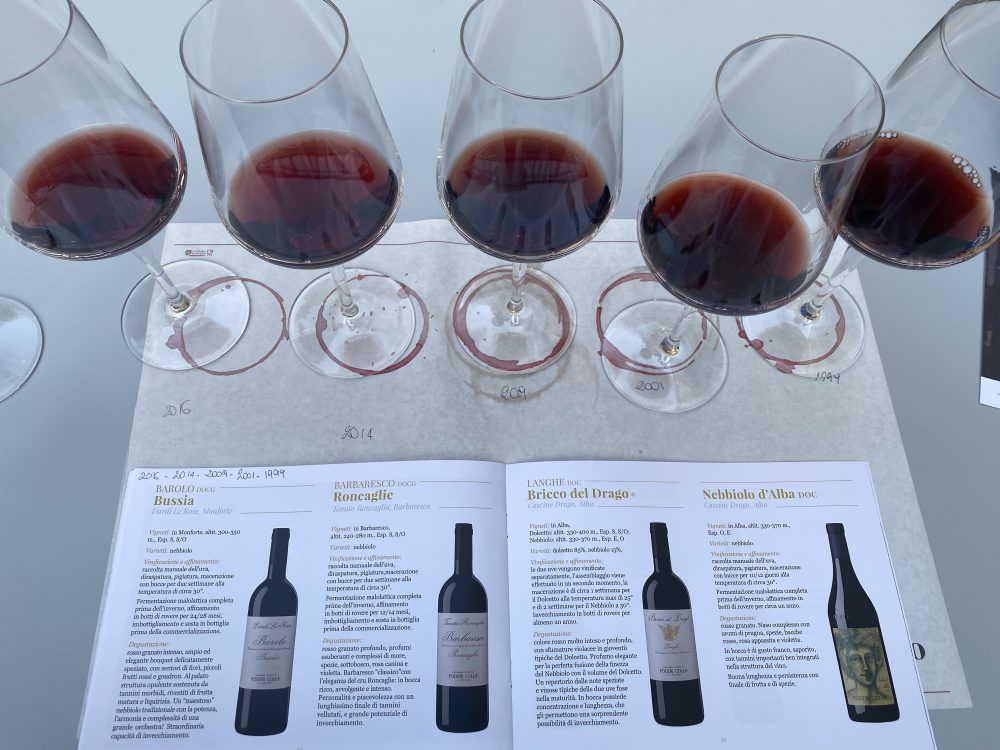
The history of Barolo and Barbaresco wines is deeply intertwined with the history of the Piedmont region in Italy.
- Barolo: The history of Barolo is longer than that of Barbaresco. Barolo wine dates back to the 19th century and is named after the town of Barolo in the Piedmont region. The wine got its name in the 1850s and was attributed to a noblewoman, the Marchesa de Barolo. Originally, Barolo was a sweet wine, bearing more resemblance to ruby Port or a very fruit-forward Shiraz, as sweetness complements the astringency of high tannins. Over time, the production methods evolved, and Barolo has become known as a dry, robust red wine with strong tannins and rich flavors.
- Barbaresco: Barbaresco, on the other hand, began its journey in 1894, around 50 years after Barolo. Like Barolo, Barbaresco is also made from the Nebbiolo grape but was initially seen as the lesser of the two due to its more approachable style and earlier drinking window. The region suffered greatly due to Phylloxera and struggled to produce wines during the World Wars. It wasn’t until after World War II that the quality of Barbaresco wines began to rise, largely due to efforts by the Gaja family and the Produttori del Barbaresco, a consortium of small producers established in 1958.
These wines’ history is a testament to the resilience and dedication of the people of Piedmont, and their continuous efforts have ensured that Barolo and Barbaresco wines continue to be enjoyed by wine lovers worldwide. 🍷🇮🇹
Is Barbaresco better than Barolo?
“Is Barbaresco better than Barolo?” is a question that doesn’t necessarily have a definitive answer, as it depends on individual preferences and the particular wines in question. Both Barbaresco and Barolo wines are made from the Nebbiolo grape and are renowned for their quality and complexity, but they do have some key differences which might influence preference.
Barolo is often characterized by its bold, full-bodied profile, high tannins, and potential for long aging. It’s known for deep flavors of cherry, anise, and leather, and a characteristic tar and rose bouquet. Barolo wines must be aged for at least 38 months, 18 of which in wooden barrels, and for a Riserva wine, this goes up to 62 months.
Barbaresco, on the other hand, is often slightly lighter, more elegant and approachable at an earlier age. The flavor profile is similar to Barolo, but the tannins tend to be a little softer and the fruit a bit more pronounced. Barbaresco wines require a minimum of 26 months of aging, 9 of which in wooden barrels, and 50 months for a Riserva.
While some wine lovers might prefer the robust, powerful character of a Barolo, others might be drawn to the more delicate, accessible nature of a Barbaresco. It’s also worth noting that both wines have excellent aging potential and can evolve and change dramatically over time. Ultimately, the “better” wine is the one that best suits your personal taste, the occasion, and the meal with which it’s served.
Does Barbaresco need decanting?
Decanting can help to soften the tannins and open up the flavors in a Barbaresco, especially for younger wines. However, it’s not strictly necessary, especially for older, more delicate vintages.
Is Barbaresco a Sangiovese?
No, Barbaresco is not a Sangiovese. It is a wine made from the Nebbiolo grape. Sangiovese is a different variety of grape, used to produce wines such as Chianti and Brunello di Montalcino.
Is Barbaresco a Super Tuscan?
No, Barbaresco is not a Super Tuscan. Super Tuscans are wines produced in Tuscany that do not adhere to the traditional grape blending regulations of the region, often incorporating non-native varieties like Cabernet Sauvignon. Barbaresco, on the other hand, is a Piedmontese wine made from the native Nebbiolo grape.
Is Barbaresco Nebbiolo grape?
Yes, Barbaresco is made from the Nebbiolo grape. It’s one of the key wine styles, along with Barolo, produced from this grape variety in the Piedmont region of Italy.
Is Nebbiolo the same as Barbaresco?
Nebbiolo is the grape variety used to make Barbaresco. However, they are not the same, as Nebbiolo refers to the type of grape, and Barbaresco refers to the specific style of wine made from Nebbiolo grapes in the Barbaresco region of Piedmont, Italy.
